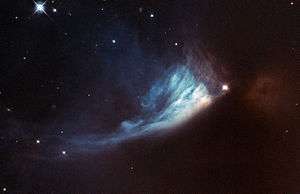PV Cephei
PV Cephei is variable star of Orion type located in the constellation of Cepheus at a distance of over 1600 light-years from Earth.[1] Although the terms 'Orion variable/Orion type' are now no longer used by most astronomers. The term 'Young Stellar Object' or YSO is preferred, since 'Orion Variable' is a term which was given at a time when these objects were thought to be more homogeneous than is now known to be the case. It has been used by the CGVS compilers but astronomers generally do not use these terms any more.
 PV Cep is the bright spot located at the edge of Gyulbudaghian’s Nebula Credit: ESA/Hubble & NASA. Acknowledgement: Alexey Romashin | |
| Observation data Epoch J2000 Equinox J2000 | |
|---|---|
| Constellation | Cepheus[1] |
| Right ascension | 20h 45m 53.943s[2] |
| Declination | +67° 57′ 38.66″[2] |
| Apparent magnitude (V) | 14.58 - 18.08[3] |
| Characteristics | |
| Spectral type | A5Ve[4] |
| Variable type | T Tau[5] |
| Astrometry | |
| Proper motion (μ) | RA: 8.228[6] mas/yr Dec.: −1.976[6] mas/yr |
| Parallax (π) | 2.9100 ± 0.0593[6] mas |
| Distance | 1,120 ± 20 ly (344 ± 7 pc) |
| Details | |
| Mass | 2.6[7] M☉ |
| Radius | 2.9[7] R☉ |
| Luminosity | 1[8] - 100[3] L☉ |
| Temperature | 8,150[8] K |
| Age | <1[3] Myr |
| Database references | |
| SIMBAD | data |
References
- "A changing fan". ESA/Hubble Picture of the Week. Retrieved 23 April 2013.
- Cutri, R. M.; Skrutskie, M. F.; Van Dyk, S.; Beichman, C. A.; Carpenter, J. M.; Chester, T.; Cambresy, L.; Evans, T.; Fowler, J.; Gizis, J.; Howard, E.; Huchra, J.; Jarrett, T.; Kopan, E. L.; Kirkpatrick, J. D.; Light, R. M.; Marsh, K. A.; McCallon, H.; Schneider, S.; Stiening, R.; Sykes, M.; Weinberg, M.; Wheaton, W. A.; Wheelock, S.; Zacarias, N. (2003). "VizieR Online Data Catalog: 2MASS All-Sky Catalog of Point Sources (Cutri+ 2003)". VizieR On-line Data Catalog: II/246. Originally Published in: 2003yCat.2246....0C. 2246. Bibcode:2003yCat.2246....0C.
- Kun, M.; Szegedi-Elek, E.; Moór, A.; Kóspál, Á.; Ábrahám, P.; Apai, D.; Kiss, Z. T.; Klagyivik, P.; Magakian, T. Yu.; Mező, Gy.; Movsessian, T. A.; Pál, A.; Rácz, M.; Rogers, J. (2011). "Inner disc rearrangement revealed by dramatic brightness variations in the young star PV Cep". Monthly Notices of the Royal Astronomical Society. 413 (4): 2689. arXiv:1101.2329. Bibcode:2011MNRAS.413.2689K. doi:10.1111/j.1365-2966.2011.18341.x.
- Watson, C. L. (2006). "The International Variable Star Index (VSX)". The Society for Astronomical Sciences 25th Annual Symposium on Telescope Science. Held May 23–25. 25: 47. Bibcode:2006SASS...25...47W.
- Samus, N. N.; Durlevich, O. V.; et al. (2009). "VizieR Online Data Catalog: General Catalogue of Variable Stars (Samus+ 2007-2013)". VizieR On-line Data Catalog: B/gcvs. Originally Published in: 2009yCat....102025S. 1. Bibcode:2009yCat....102025S.
- Brown, A. G. A.; et al. (Gaia collaboration) (August 2018). "Gaia Data Release 2: Summary of the contents and survey properties". Astronomy & Astrophysics. 616. A1. arXiv:1804.09365. Bibcode:2018A&A...616A...1G. doi:10.1051/0004-6361/201833051. Gaia DR2 record for this source at VizieR.
- Caratti o Garatti, A.; Garcia Lopez, R.; Weigelt, G.; Tambovtseva, L. V.; Grinin, V. P.; Wheelwright, H.; Ilee, J. D. (2013). "LBT/LUCIFER near-infrared spectroscopy of PV Cephei. An outbursting young stellar object with an asymmetric jet". Astronomy and Astrophysics. 554: A66. arXiv:1304.6267. Bibcode:2013A&A...554A..66C. doi:10.1051/0004-6361/201321418.
- Vioque, M.; Oudmaijer, R. D.; Baines, D.; Mendigutía, I.; Pérez-Martínez, R. (2018). "Gaia DR2 study of Herbig Ae/Be stars". Astronomy and Astrophysics. 620: A128. arXiv:1808.00476. Bibcode:2018A&A...620A.128V. doi:10.1051/0004-6361/201832870.
This article is issued from Wikipedia. The text is licensed under Creative Commons - Attribution - Sharealike. Additional terms may apply for the media files.